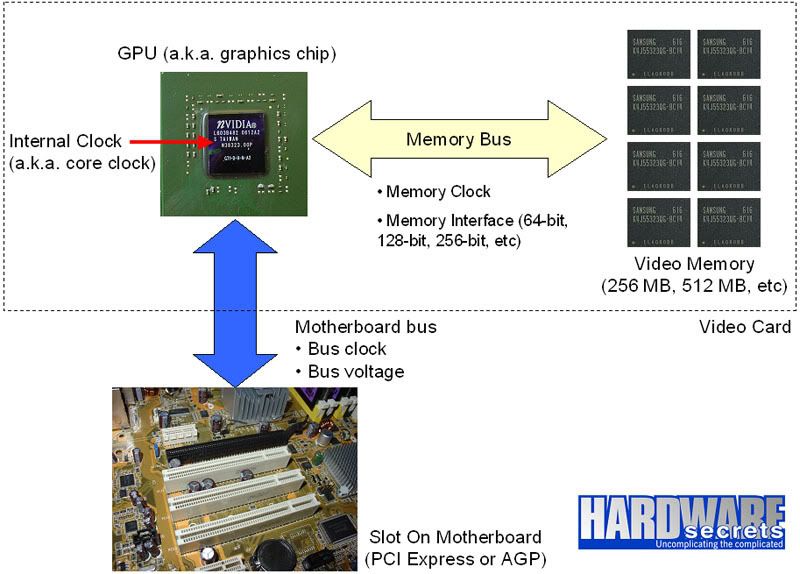Introduction
You can increase the gaming performance of your computer by overclocking your video card. Overclocking is a technique that makes a given hardware part to operate at a clock frequency above its standard frequency, thus increasing its performance. In this tutorial we will explain in details how to overclock your video card, with several tips and tricks.
If your PC has a video card embedded on the motherboard (i.e. “on-board video”) you won’t be able to overclock it, as you PC doesn’t have a real video card installed – the video is produced by the motherboard chipset. In this tutorial we deal exclusively with real video cards, the ones that are connected to your PC thru an expansion slot.
To learn how to overclock you video card you need to learn first how a video card works. On Figure 1 you can see a very basic diagram showing the video card main components and how they are connected together.
The heart of a video card is its graphics chip, also known as GPU, Graphics Processing Unit. It works at a certain clock rate, also known as “core clock” or “engine clock”. When we think of overclocking a video card, usually the first thing that comes to mind is to increase the GPU core clock.
The new GeForce 8 GPU series from nVidia has two clock signals, one used by its shader engines and another used by the rest of the chip (the core clock we’ve just described). So far we don’t know if this second signal (shader clock) can be overclocked or not, or if it is somehow connected to the core clock. We will update this tutorial as soon as we get one video card based on this new architecture in order to clarify this issue.
The GPU is connected to the video memory (which is physically located on the video card) using a dedicated memory bus (yellow on Figure 1). This bus also works at a certain clock rate, also known as “memory clock”. We can also increase this clock rate in order to increase the performance of your video card and of course we will show you how to do that.
One important thing to keep in mind right now is that the memory bus nowadays usually works transferring two data per clock cycle, technique known as DDR, Double Data Rate. Because of this technique the memory clock can sometimes be referred as the double of its real clock rate, because the transfer rate achieved by DDR technique is double the transfer rate of a regular memory transferring just one data per clock cycle. In order to avoid confusion during our tutorial we will add the letters DDR after clock rates that are “doubled”. For instance 300 MHz and 600 MHz DDR are the same thing, as this 600 MHz DDR clock rate is really 300 MHz transferring two data per clock cycle.
The memory bus – which can also be referred to as memory interface – transfers a certain number of bits per time between the GPU and the video memory – 64 bits, 128 bits, 256 bits, etc. This number is fixed and you cannot change it. In other words there is no way for you to transform your 128-bit video card into a 256-bit one. This is a physical limitation: each bit is transferred thru an individual wire on the video card printed circuit board, so a video card with a 128-bit memory interface has 128 wires connecting the GPU to the memory. So it is impossible to change this number, as you would need to add 128 more wires between the GPU and the memory chips (and also probably add or change the memory chips). The same thing goes for the video memory size: you cannot transform your 128 MB video card into a 256 MB one simply because you would need to add more memory chips to it.
The GPU is connected to the motherboard thru an I/O slot such as PCI Express and AGP. This connection is also done at a certain clock rate (100 MHz for PCI Express and 66 MHz for AGP) and some motherboards allow you to increase this clock rate, giving a third option to overclock your video card. Notice that this option depends on the motherboard and not on the video card, as it is the motherboard that controls the I/O slot where the video card is installed. Some overclocking-oriented motherboards also provide an option for you to increase the I/O slot voltage (i.e. the video card voltage), which can make your video card to achieve a higher overclocking.
Monday, January 1, 2007
How to Overclock Your Video Card
Posted by Ashish at 10:20 PM
Labels: Computer-Tweaks
Subscribe to:
Post Comments (Atom)

0 comments:
Post a Comment